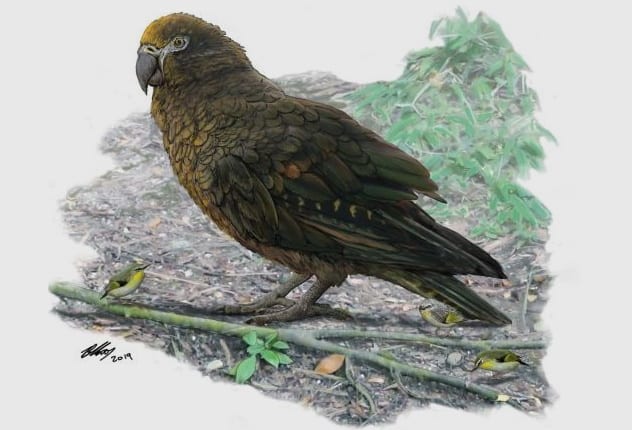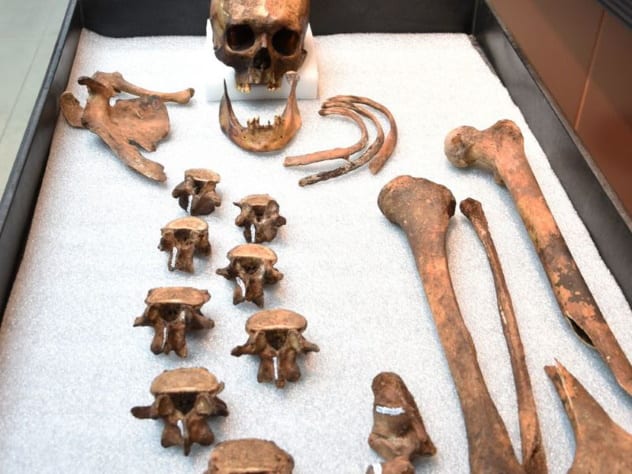 Politics
Politics  Politics
Politics  Weird Stuff
Weird Stuff 10 Eggs-traordinarily Odd Eggs
 History
History 10 Desperate Last Stands That Ended in Victory
 Animals
Animals Ten Times It Rained Animals (Yes, Animals)
 Mysteries
Mysteries 10 Devastating Missing Child Cases That Remain Unsolved
 Creepy
Creepy 10 Scary Tales from the Middle Ages That’ll Keep You up at Night
 Humans
Humans 10 One-of-a-kind People the World Said Goodbye to in July 2024
 Movies and TV
Movies and TV 10 Holiday Movies Released at Odd Times of the Year
 Politics
Politics 10 Countries Where Religion and Politics Are Inseparable
 Weird Stuff
Weird Stuff 10 Freaky Times When Famous Body Parts Were Stolen
 Politics
Politics The 10 Most Bizarre Presidential Elections in Human History
 Weird Stuff
Weird Stuff 10 Eggs-traordinarily Odd Eggs
 History
History 10 Desperate Last Stands That Ended in Victory
Who's Behind Listverse?

Jamie Frater
Head Editor
Jamie founded Listverse due to an insatiable desire to share fascinating, obscure, and bizarre facts. He has been a guest speaker on numerous national radio and television stations and is a five time published author.
More About Us Animals
Animals Ten Times It Rained Animals (Yes, Animals)
 Mysteries
Mysteries 10 Devastating Missing Child Cases That Remain Unsolved
 Creepy
Creepy 10 Scary Tales from the Middle Ages That’ll Keep You up at Night
 Humans
Humans 10 One-of-a-kind People the World Said Goodbye to in July 2024
 Movies and TV
Movies and TV 10 Holiday Movies Released at Odd Times of the Year
 Politics
Politics 10 Countries Where Religion and Politics Are Inseparable
 Weird Stuff
Weird Stuff 10 Freaky Times When Famous Body Parts Were Stolen
10 Offbeat Stories You Might Have Missed This Week (8/10/19)
With another week in the history books, it’s time to sit back and review some of the stories that made the news over the last few days. Click here if you want to learn all about the unexpected and outlandish stories from last week.
This time, we discuss the real possibility that there might be life on the Moon, but before you get too excited, we brought it there from Earth. We also look at two men, one a basketball player and the other a Brazilian drug dealer, who tried to use the women close to them in order to cheat. Although they had vastly different goals in mind, both of them failed.
10 An Unlikely Pregnancy

A male basketball player was caught trying to cheat a doping test after the results showed that he was pregnant.
Donell “D.J.” Cooper entered the 2013 NBA draft. He went unsigned and, instead, played for various European basketball teams. In 2018, he tried to join the Bosnian national team as a naturalized player. He didn’t make the cut and also did not play with any other team the whole year.
Now we know why: FIBA had suspended him two years for fraud. A drug test revealed the presence of human chorionic gonadotropin or hCG. However, this is not a performance-enhancing drug but rather a hormone created by the placenta during pregnancy. Since there was a pretty decent chance that Cooper was not, in fact, pregnant, this meant that he tried to pass off someone else’s urine as his own. Reportedly, it belonged to his girlfriend.[1]
9 For Sale: Volcano

If you are an aspiring supervillain on a tight budget, you probably can’t afford a skull-shaped island for your secret lair. Fortunately, now you can buy the next best thing for a reasonable £50,000 ($61,000)—a 250-million-year-old inactive volcano.[2]
Located in Devon, England, the ancient geological feature sits next to a tiny settlement called Posbury. Despite its diminutive size, the community has been occupied since the Iron Age and had long contained a quarry which mined basalt stone. The volcano itself is known as the Posbury Clump because it rests underneath a thick woodland.
The area has also been designated a Site of Special Scientific Interest because you can still find signs of potassium-rich lava dating all the way back to the Permian Period, when dinosaurs were just starting to appear on this planet.
8 Terrifyingly Thunderous Toilet Trouble

There was a “first in plumbing history” as lightning hit a house’s septic tank, causing the toilet to explode.
Early Sunday morning, Marylou Ward and her husband were still in bed in their Port Charlotte, Florida, home when they felt the house rocked by a loud explosion. They were shocked to discover that the toilet in their master bathroom blew up. The force was powerful enough to shatter it completely and send pieces of porcelain flying with enough strength to penetrate the wall.
When the Wards brought in a plumber to assess the damage, he said that neither he nor his father had ever seen anything like it despite decades of experience. Besides the toilet, the sanitary pipe and the lid of the septic tank had both disintegrated.
The cause of the explosion was a buildup of methane gas in the septic tank.[3] Once it got hit by lightning, it ignited with a powerful blast. Jordan Hagadorn, the plumber who inspected the wreckage, said that the tank lid was only buried 2.5 centimeters (1 in) underground, which could have helped facilitate the explosion.
7 Hercules The Parrot

Prehistoric times were filled with giant versions of animals that are still around today. Now, there is a new one to add to the list: Heracles inexpectatus, the Hercules parrot.
The large bird was described for the first time a few days ago in Biology Letters from fossils found over a decade ago in St Bathans, Otago, New Zealand. They are roughly 19 million years old and once belonged to a parrot that stood 1 meter (3’3″) tall and weighed up to seven kilograms (15 lb).[4]
By comparison, the kakapo, the largest extant parrot species, rarely exceeds half that amount. In fact, researchers believe the two might be related, both part of the Nestoridae family, or the New Zealand parrot, as it’s better known.
Gigantism is a common trait in New Zealand’s bird population, one that likely arose from a lack of competition from mammals or reptiles. However, it has never been seen before in parrots.
6 The Identity Of The New England Vampire

Back in the 19th century, rural New England succumbed to a vampire panic. Entire families were being ravaged by tuberculosis, but they ascribed the plague to their departed love ones, who were coming back from the dead. To counter this affliction, people dug up the bodies of the dead and performed various rites on them. Most common was burning the heart.
Most of these events were done in private, although there were a few cases, like that of Mercy Brown, where the entire village took part. Out of dozens of documented cases, only one left physical evidence for modern archaeologists. Back in 1990, boys stumbled upon the remains of a “vampire” in Griswold, Connecticut, and now, researchers believe they have identified him.
On the coffin, tacks were used to spell out “JB 55,” most likely the deceased’s initials and age. Inside where the remains of a middle-aged man, most likely a farmer or laborer based on the arthritis in his bones, who, indeed, suffered from tuberculosis. He had also clearly been the target of an anti-vampire ritual. His skull had been severed from the spine and placed on the chest alongside his femurs to form a skull and crossbones. His body had also been dug up after burial, and his heart had been removed and, most likely, incinerated.[5]
Researchers used modern forensics to analyze the remains but also dug through old records. They found an obituary from 1826 for a young boy called Nicholas Barber which also made mention of his deceased father, a farmer named John Barber, whose initials and age estimate match the markings on the coffin. Moreover, next to the grave was another coffin with tacks spelling out “NB 13,” likely that of Nicholas.
Scientists are pretty confident that John Barber was the New England vampire, although they don’t know what he did to earn that reputation other than dying of tuberculosis.
5 Atomik Vodka

Bartenders from Bar Swift in fashionable Soho, London, made the first-ever Atomik martini. It is one of the rarest drinks on the planet because only one bottle of the vodka used to make it exists. Also called Atomik, the spirit was made using water and grain from Chernobyl.
The “artisan vodka” is the work of a team of British scientists from the University of Portsmouth. First, they grew rye grain on a farm located inside the Exclusion Zone surrounding the nuclear power plant in Ukraine. Then they harvested the crops, mixed them with water from the Chernobyl aquifer, and distilled them to make vodka.
Team leader Professor Jim Smith assures everyone that their spirit “is no more radioactive than any other vodka.”[6] Tests run at the radioanalytical laboratory at Southampton University found no signs of radioactivity.
Alongside other scientists, the team behind Atomik vodka formed the Chernobyl Spirit Company. They plan to make 500 bottles by the end of the year and use profits from their sales to help out the Ukrainian communities surrounding the Exclusion Zone.
4 Incognito Inmate Caught In Flagrante

A Brazilian drug dealer tried to escape prison by disguising himself as his visiting daughter.
Clauvino da Silva was facing a 73-year sentence in Bangu 3, a prison in Rio de Janeiro. He fled confinement once in 2013 during a mass prison escape, but this time, he tried something a bit more unusual.
Last week, his 19-year-old daughter came to visit him. Then, da Silva tried to pass himself off as her by donning a silicone mask, wig, glasses, bra, and shirt.[7] Perhaps he was hoping that the guards would not pay too much attention, and he could simply walk out of the prison while his daughter stayed behind.
Alas, authorities were not fooled. Da Silva was brought back to his cell after guards documented his bizarre escape plan. Officials are still debating whether to file charges against his daughter for aiding a criminal. Other people who visited him recently are also being questioned because one of them likely smuggled in the disguise.
Earlier this week, da Silva was found dead in his cell. It appears that he had taken his own life following the foiled prison escape.
3 Legalize It, Accidentally

It appears that Ohio lawmakers unintentionally legalized marijuana, at least for the time being.
On July 30, Governor Mike DeWine signed a new bill which legalized hemp to give farmers access to a new crop. Marijuana was still illicit, though, and the differentiation between the two was made through THC content. Anything with THC levels at or below 0.3 percent was legal hemp; anything above it was illegal marijuana.
Here is the problem, though: There is no lab in the state capable of telling the difference. Their analysis can detect the presence of THC, not the quantity. Even the Ohio Bureau of Criminal Investigation (BCI) and the Columbus Police Department are ill-equipped to handle this task.
Some officials raised these concerns during debate for the bill but were dismissed. Ohio Attorney General Dave Yost told prosecutors that the BCI is in early stages of developing new methods to enforce the new law but that the process “may take several months.”[8]
Until then, marijuana in Ohio is de facto legal. The BCI recommended that prosecutors stop indicting any cannabis-related charges, and the Ohio Prosecuting Attorneys Association agreed. Meanwhile, the Columbus City Attorney’s office said that not only will it not prosecute misdemeanor cases, but it will also drop any pending pot charges.
2 Sail Like An Egyptian

There is an odd sight in Bulgaria, on the edge of Lake Varna: A team of researchers and master shipbuilders are working on a reed boat just like the ones built by the ancient Egyptians thousands of years ago. Once it is finished, they plan to sail it 3,000 kilometers (1,900 mi) across three seas to Cyprus.
The project is headed by 53-year-old German archaeologist Dominique Gorlitz. Its goal is to serve as proof of concept, showing that this was a journey that could have been undertaken by Egyptian seafarers in ancient times.[9]
Gorlitz asserted that Egyptian merchants traveled to the Caucuses and brought back iron, which was used during the building of the pyramids. He was part of a group that studied iron traces left on the giant stone blocks used to construct Khufu’s Great Pyramid of Giza.
To maintain authenticity, the reed boat is being built with the help of an expert team from Bolivia, some of the few who still employ traditional techniques to construct this ancient vessel. They plan to take it out on Lake Varna for trials soon and, later this month, set sail on the Black Sea. From there, they will have to pass through the Bosphorus and the Dardanelles straits, crossing the Sea of Marmara and into the Aegean.
1 Would You Believe They Put Water Bears On The Moon?

There might be life on the Moon, although it came from Earth. The Israeli probe Beresheet, which crashed on the satellite in April, was carrying thousands of tardigrades. Experts believe not only that the tiny resilient creatures survived the impact but that they could withstand the conditions on the Moon for years to come.[10]
Tardigrades, also called water bears, have long fascinated both scientists and laymen alike for their seemingly boundless durability. Whenever they find themselves in unsuitable conditions, they shrivel up and enter a hibernating state called “tun.” This way, they can survive both freezing and scorching temperatures, huge amounts of radiation, and even the vacuum of space. They can stay this way for years and be revived afterward by simply getting dropped in water.
Scientists think it is possible that the tardigrades will stay tun until someone comes, picks them up, and brings them back to Earth, where they can be revived. Of course, there is no immediate plan for a rescue operation; it’s just something to consider down the line whenever a new mission to the Moon is scheduled.
Astrobiologist Philippe Reekie adds a caveat: Tardigrades can absolutely survive on the Moon, but only in tun state. If the critters are active, then they are quite feeble and easy to kill, so it all depends on their status when the probe impacted the Moon.
Read more offbeat stories you might have missed from August 3, 2019, and July 27, 2019.








